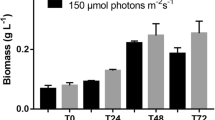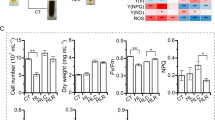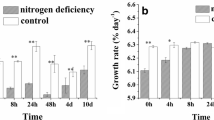Abstract
Photosynthetic diatoms are exposed to a rapid and unexpected variations in light intensity that can modulate the contents of photosynthetic pigments and the carotenoid profile. In this study, the influence of light availability on photoprotection in the diatom Phaeodactylum tricornutum was investigated. Experimental cultures were exposed to three irradiances (100, 200 and 400 µmol photons m−2 s−1) and two light: dark cycles (12:12 and 24:00 h) that resulted in different light energy daily doses (D = 4.32 mol photons m−2), where the treatments were named in NDxh (N = amount of daily doses D, and x = photoperiod in hours). The samples treated at different doses were compared in terms of cell growth, chlorophyll-a fluorescence, pigment content and gene transcription levels. Specific growth rate was 1.9-fold higher in 8D24h daily dose (34.56 mol photons m−2) with 3 times higher light absorption in comparison to the lowest light energy dose. Also, at higher light intensities the content of chlorophyll-a, fucoxanthin and diadinoxanthin in P. tricornutum was lower, while the regulation of the xanthophyll cycle was achieved by the highest light energy doses. The transcriptional profiles of ZEP1, ZEP2, VDL1 and VDL2 genes were influenced by the highest light energy doses, on the other hand VDE and ZEP3 genes were poorly regulated by light. In addition, a similar transcription pattern was found for two isoforms of ZEP genes as well as in VDL genes. This study demonstrated that light energy doses and irradiances affect the photoacclimation and photoprotection responses.








Similar content being viewed by others
Data availability
Data will be made available on request.
References
Andrade KAM, Lauritano C, Romano G, Ianora A (2018) Marine microalgae with anti-cancer properties. Mar Drugs 16:165
APHA (2011) Standard methods for the examination of water and waste water. American Public Health Association, Washington DC
Armbrust EV, Berges JA, Bowler C, Green BR, Martinez D, Putnam NH, Zhou S, Allen AE, Apt KE, Bechner M et al (2004) The genome of the diatom Thalassiosira pseudonana: ecology, evolution, and metabolism. Science 306:79–86
Bai Y, Cao T, Dautermann O, Buschbeck P, Cantrell MB, Chen Y, Lein CD, Shi X, Ware MA, Yang F, Zhang H, Zhang L, Peers G, Li X, Lohr M (2022) Green diatom mutants reveal an intricate biosynthetic pathway of fucoxanthin. Proc Natl Acad Sci U S A 119:e2203708119
Bauer CM, Schmitz C, Corrêa RG, Herrera CM, Ramlov F, Oliveira ER, Pizzato A, Varela LAC, Cabral DQ, Yunes RA, Lopes RG, Cella H, Rocha M, Rorig LR, Derner RB, Abreu PC, Maraschin M (2019) In vitro fucoxanthin production by the Phaeodactylum tricornutum diatom. In: Rahman A (ed) Studies in Natural Products Chemistry, vol 63. Elsevier, Amsterdam, pp 211–242
Blommaert L, Chafai L, Bailleul B (2021) The fine-tuning of NPQ in diatoms relies on the regulation of both xanthophyll cycle enzymes. Sci Rep 11:12750
Bowler C, Allen AE, Badger JH, Grimwood J, Jabbari K, Kuo A, Maheswari U, Martens C, Maumus F, Otillar RP et al (2008) Phaeodactylum tricornutum genome reveals the evolutionaty history of diatom genomes. Nature 456:239–244
Broddrick JT, Du N, Smith SR, Tsuji Y, Jallet D, Ware MA, Peers G, Matsuda Y, Dupont CL, Mitchell BG, Palsson BO, Allen AE (2019) Cross-compartment metabolic coupling enables flexible photoprotective mechanisms in the diatom Phaeodactylum tricornutum. New Phytol 222:1364–1379
Büchel C, Goss R, Bailleul B, Campbell D, Lavaud J, Lepetit B (2022) Photosynthetic light reactions in diatoms. I. The lipids and light-harvesting complexes of the thylakoid membrane. In: Falciatore A, Mock T (eds) The molecular life of diatoms. Springer, Cham, pp 397–422
Bunsen R, Roscoe H (1859) Photochemische untersuchungen. Ann Phys Chem 184:193–273
Coesel S, Oborník M, Varela J, Falciatore A, Bowler C (2008) Evolutionary origins and functions of the carotenoid biosynthetic pathway in marine diatoms. PLoS One 3:e2896
Conceição D, Lopes RG, Derner RB, Cella H, do Carmo APB, D’Oca MGM, Petersen R, Passos MF, Vargas JVC, Galli-Terasawa LV, Kava V (2020) The effect of light intensity on the production and accumulation of pigments and fatty acids in Phaeodactylum tricornutum. J Appl Phycol 32:1017-1025
Costa BS, Jungandreas A, Jakob T, Weisheit W, Mittag M, Wilhelm C (2013) Blue light is essential for high light acclimation and photoprotection in the diatom Phaeodactylum tricornutum. J Exp Bot 64:483–493
Dambek M, Eilers U, Breitenback J, Steiger S, Büchel C, Sandmann G (2012) Biosynthesis of fucoxanthin and diadinoxanthin and function of initial pathway genes in Phaeodactylum tricornutum. J Exp Bot 63:5607–5612
Dautermann O, Lohr M (2017) A functional zeaxanthin epoxidase from red algae shedding light on the evolution of light-harvesting carotenoids and the xanthophyll cycle in photosynthetic eukaryotes. Plant J 92:879–891
Dautermann O, Lyska D, Andersen-Ranberg J, Becker M, Fröhlich-Nowolsky J, Gartmann H, Krämer LC, Mayr K, Pleper D, Rij LM, Wipf HM-L, Niyogi KK, Lohr M (2020) An algal enzyme required for biosynthesis of the most abundant marine carotenoids. Sci Adv 6:eaaw9183
Depauw FA, Rogato A, d’Alcalà MR, Falciatore A (2012) Exploring the molecular basis of responses to light in marine diatoms. J Exp Bot 63:1575–1591
Eilers U, Dietzel L, Breitenbach J, Büchel C, Sandmann G (2016) Identification of genes coding for functional zeaxanthin epoxidases in the diatom Phaeodactylum tricornutum. J Plant Physiol 192:64–70
Enríquez S, Borowitzka MA (2010) The use of the fluorescence signal in studies of seagrasses and macroalgae. In: Suggett DJ, Prášil O, Borowitzka MA (eds) Chlorophyll a Fluorescence in Aquatic Sciences: Methods and Applications. Springer, Dordrecht, pp 187–208
Falciatore A, Jaubert M, Bouly J, Bailleul B, Mock T (2020) Diatom molecular research comes of age: model species for studying phytoplankton biology and diversity. Plant Cell 32:547–572
Fisher NL, Campbell DA, Hughes DJ, Kuzhiumparambil U, Halsey KH, Ralph PJ, Suggett DJ (2020) Divergence of photosynthetic strategies amongst marine diatoms. PLoS One 15:e0244252
Gelzinis A, Buktus V, Songaila E, Augulis R, Gall A, Büchel C, Robert B, Abramavicius D, Zigmantas D, Valkunas L (2015) Mapping energy transfer channels in fucoxanthin-chlorophyll protein complex. Biochim Biophys Acta 1847:241–247
Goss R, Lepetit B (2015) Biodiversity of NPQ. J Plant Physiol 172:13–32
Hippmann AA, Schuback N, Moon KM, McCrow JP, Allen AE, Foster LF, Green BR, Maldonado MT (2022) Proteomic analysis of metabolic pathways supports chloroplast-mitochondria cross-talk in a Cu-limited diatom. Plant Direct 6:e376
Jeffrey SW, Humphrey GF (1975) New spectrophotometric equation for determining chlorophylls a, b, c1 and c2 in higher plants, algae and natural populations. Biochem Physiol Pflanzen 167:191–194
Johnsen G, Sakshaug E (2007) Biooptical characteristics of PSII and PSI in 33 species (13 pigment groups) of marine phytoplankton, and the relevance for pulse-amplitude-modulated and fast-repetition-rate fluorometry. J Phycol 43:1236–1251
Krause-Jensen D, Sand-Jensen K (1998) Light attenuation and photosynthesis of aquatic plant communities. Limnol Oceanogr 43:396–407
Kuczynska P, Jemiola-Rzeminska M, Strzalka K (2015) Photosynthetic pigments in diatoms. Mar Drugs 13:5847–5881
Kuczynska P, Jemiola-Rzeminska M, Nowicka B, Jakubowska A, Strzalka W, Burda K, Strzalka K (2020) The xanthophyll cycle in diatom Phaeodactylum tricornutum in response to light stress. Plant Physiol Biochem 152:125–137
Lavaud J, Materna AC, Sturm S, Vugrinec S, Kroth PG (2012) Silencing of the violaxanthin de-epoxidase gene in the diatom Phaeodactylum tricornutum reduces diatoxanthin synthesis and non-photochemical quenching. PLoS One 7:e36806
Lepetit B, Volke D, Gilbert M, Wilhelm C, Goss R (2010) Evidence for the existence of one antenna-associated, lipid-dissolved and two protein-bound pools of diadinoxanthin cycle pigments in diatoms. Plant Physiol 154:1905–1920
Lepetit B, Gélin G, Lepetit M, Sturm S, Vugrinec S, Rogato A, Kroth PG, Falciatore A, Lavaud J (2017) The diatom Phaeodactylum tricornutum adjusts nonphotochemical fluorescence quenching capacity in response to dynamic light via fine-tuned Lhcx and xanthophyll cycle pigment synthesis. New Phytol 214:205–218
Lepetit B, Campbell D, Lavaud J, Büchel C, Goss R, Bailleul B (2022) Photosynthetic light reactions in diatoms. II. The dynamic regulation of the various light reactions. In: Falciatore A, Mock T (eds) The molecular life of diatoms. Springer, Cham, pp 423–464
Liu Y, Zheng J, Zhang Y, Wang Z, Yang Y, Bai M, Dai Y (2016) Fucoxanthin activates apoptosis via inhibition of PI3K/Akt/mTOR pathway and suppresses invasion and migration by restriction of p38-MMP-2/9 pathway in human glioblastoma cells. Neurochem Res 41:2728–2751
Lohr M, Wilhelm C (2001) Xanthophyll synthesis in diatoms: quantification of putative intermediates and comparison of pigment conversion kinetics with rate constants derived from a model. Planta 212:382–391
Lopes RG, Cella H, Mattos JJ, Marques MRF, Soares AT, Antoniosi-Filho NR, Derner RB, Rörig LR (2019) Effect of phosphorus and growth phases on the transcription levels of EPA biosynthesis genes in the diatom Phaeodactylum tricornutum. Braz J Bot 42:13–22
Lopes FG, Oliveira KA, Lopes RG, Poluceno GG, Simioni C, Silva GP, Bauer CM, Maraschin M, Derner RB, Garcez RG, Tasca CI, Nedel CB (2020) Anti-cancer effects of fucoxanthin on human glioblastoma cell line. Anticancer Res 40:6799–6815
Malapascua JRF, Jerez CG, Sergejevová M, Figueroa FL, Masojídek J (2014) Photosynthesis monitoring to optimize growth of microalgal mass cultures: application of chlorophyll fluorescence techniques. Aquat Biol 22:123–140
Masojídek J, Torzillo G, Koblizek M (2013) Photosynthesis in microalgae. In: Richmond A, Hu Q (eds) Handbook of microalgal culture: Applied Phycology and Biotechnology. Wiley-Blackwell, Oxford, pp 21–36
Nymark M, Valle KC, Brembu T, Hancke K, Winge P, Andresen K, Johnsen G, Bones AM (2013) Molecular and photosynthetic responses to prolonged darkness and subsequent acclimation to re-illumination in the diatom Phaeodactylum tricornutum. PLoS One 8:e58722
Pajot A, Lavaud J, Carrier G, Lacour T, Marchal L, Nicolau E (2023) Light-response in two clonal strains of the haptophyte Tisochrysis lutea: Evidence for different photoprotection strategies. Algal Res 69:102915
Ragni M, d’Alcalà MR (2007) Circadian variability in the photobiology of Phaeodactylum tricornutum: pigment content. J Plankton Res 29:141–156
Ramanan C, Berera R, Gundermannb K, Stokkum I, Büchel C, Grondelle R (2014) Exploring the mechanism(s) of energy dissipation in the light harvesting complex of the photosynthetic algae Cyclotella meneghiniana. Biochim Biophys Acta 1837:1507–1513
Rhinn H, Scherman D, Escriou V (2008) One-step quantification of single-stranded DNA in the presence of RNA using Oligreen in a real-time polymerase chain reaction thermocycler. Anal Biochem 372:116–118
Ruban AV, Lavaud J, Rousseau B, Guglielmi G, Horton P, Etienne AL (2004) The super-excess energy dissipation in diatom algae: comparative analysis with higher plants. Photosynth Res 82:165–175
Sales R, Derner RB, Tsuzuki MY (2019) Effects of different harvesting and processing methods on Nannochloropsis oculata concentrates and their application on rotifer Brachionus sp. cultures. J Appl Phycol 31:3607–3615
Serôdio J, Lavaud J (2020) Diatoms and their ecological importance. In: Leal Filho W, Azul AM, Brandi L, Lange Salvia A, Wall T. (eds) Life Below Water. Encyclopedia of the UN Sustainable Development Goals. Springer, Cham pp 1–9
Seydoux C, Storti M, Giovagnetti V, Matuszyńska A, Guglielmino E, Zhao X, Giustini C, Pan Y, Blommaert L, Angulo J, Ruban AV, Hu H, Bailleul B, Courtois F, Allorent G, Finazzi G (2022) Impaired photoprotection in Phaeodactylum tricornutum KEA3 mutants reveals the proton regulatory circuit of diatoms light acclimation. New Phytol 234:578–591
Schmittgen TD, Livak KJ (2008) Analyzing real-time PCR data by the comparative CT method. Nat Protoc 3:1101–1108
Schmitz C, Nunes A, Bauer CM, Barufi JB, Maraschin M (2022) Monitoring the stability of the xanthophyll fucoxanthin in microalga and seaweed biomasses, and extracts stored at low temperatures. Res Soc Dev 11:e577111537712
Sharma N, Simon DP, Diaz-Garza AM, Fantino E, Messaabi A, Meddeb-Mouelhi F, Germain H, Desgagné-Penix I (2021) Diatoms biotechnology: Various industrial applications for a greener tomorrow. Front Mar Sci 8:636613
Strickland JDH, Parsons TR (1972) A Pratical Handbook of Seawater Analysis. Fisheries Research Board of Canada, Ottawa
Valle KC, Nymark M, Aamot I, Hancke K, Winge P, Andresen K, Johnsen G, Brembu T, Bones AM (2014) System responses to equal doses of photosynthetically usable radiation of blue, green, and red light in the marine diatom Phaeodactylum tricornutum. PLoS One 9:e114211
Wagner H, Jakob T, Lavaud J, Wilhelm C (2016) Photosystem II cycle activity and alternative electron transport in the diatom Phaeodactylum tricornutum under dynamic light conditions and nitrogen limitation. Photosynth Res 128:151–161
Ye Y, Huang Y, Xia A, Fu Q, Liao Q, Zeng W, Zheng Y, Zhu X (2018) Optimizing culture conditions for heterotrophic-assisted photoautotrophic biofilm growth of Chlorella vulgaris to simultaneously improve microalgae biomass and lipid productivity. Bioresour Technol 270:80–87
Zhou L, Wu S, Gu W, Wang L, Wang J, Gao S, Wang G (2021) Photosynthesis acclimation under severely fluctuating light conditions allows faster growth of diatoms compared with dinoflagellates. BMC Plant Biol 21:164
Acknowledgements
The authors would like to thank the Brazilian Ministry of Science, Technology, Innovation and Communications (MCTIC) for financial support provided.
Funding
The research was funded by the Funding Authority for Studies and Projects (FINEP) (Agreement No. 01.10.0457.00) and by the National Council for Scientific and Technological Development (CNPq) (Case No. 407513/2013–2).
Author information
Authors and Affiliations
Contributions
All authors participated in the conception and design of the experiment. HC, CN, JBB and LRR performed the fluorescence analysis. HC, CLVB and JJM performed the molecular analysis. HC, CMB and MM performed the pigment analysis. HC, JBB and CYBO interpreted the data and discussed the results. HC drafted the article. RGL, JBB, MM, LRR, ACDB, MRFM and RBD critically reviewed the article and contributed with intellectual input. All authors approved submission of the article.
Corresponding author
Ethics declarations
Competing interest
The authors declare that they have no known competing financial interests or personal relationships that could have appeared to influence the work reported in this paper.
Additional information
Publisher's note
Springer Nature remains neutral with regard to jurisdictional claims in published maps and institutional affiliations.
Supplementary Information
Below is the link to the electronic supplementary material.



Rights and permissions
Springer Nature or its licensor (e.g. a society or other partner) holds exclusive rights to this article under a publishing agreement with the author(s) or other rightsholder(s); author self-archiving of the accepted manuscript version of this article is solely governed by the terms of such publishing agreement and applicable law.
About this article
Cite this article
Cella, H., Nader, C., Bastolla, C.L.V. et al. PAR regulation of photoprotection in Phaeodactylum tricornutum (Bacillariophyceae): Roles of doses and irradiances. J Appl Phycol 35, 2177–2191 (2023). https://doi.org/10.1007/s10811-023-03042-8
Received:
Revised:
Accepted:
Published:
Issue Date:
DOI: https://doi.org/10.1007/s10811-023-03042-8




